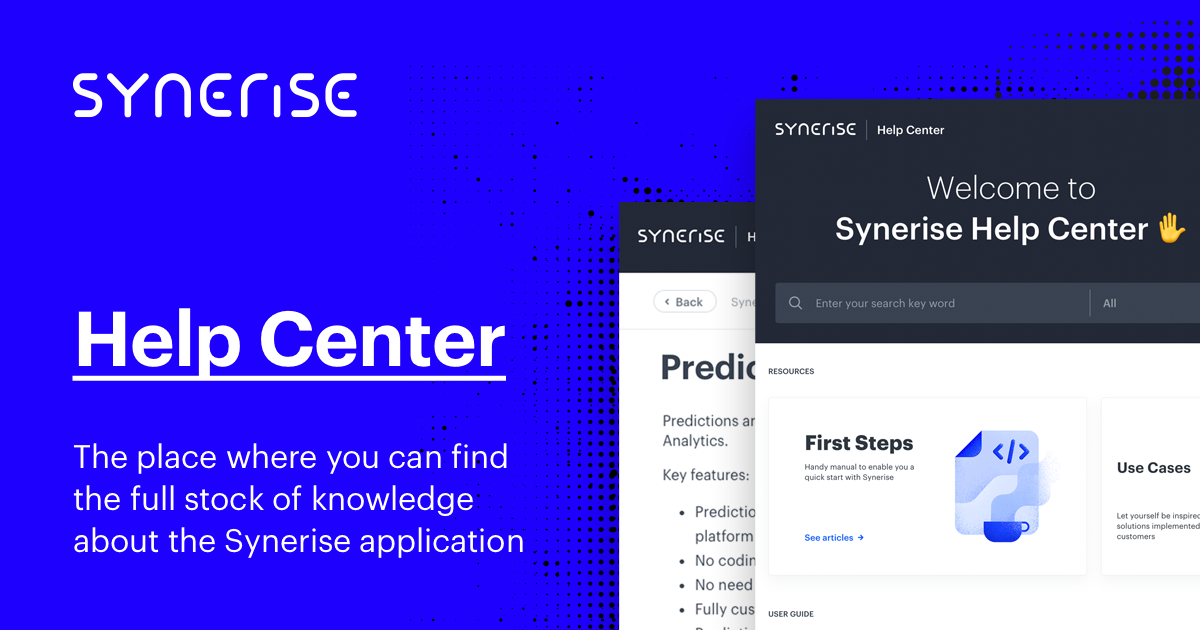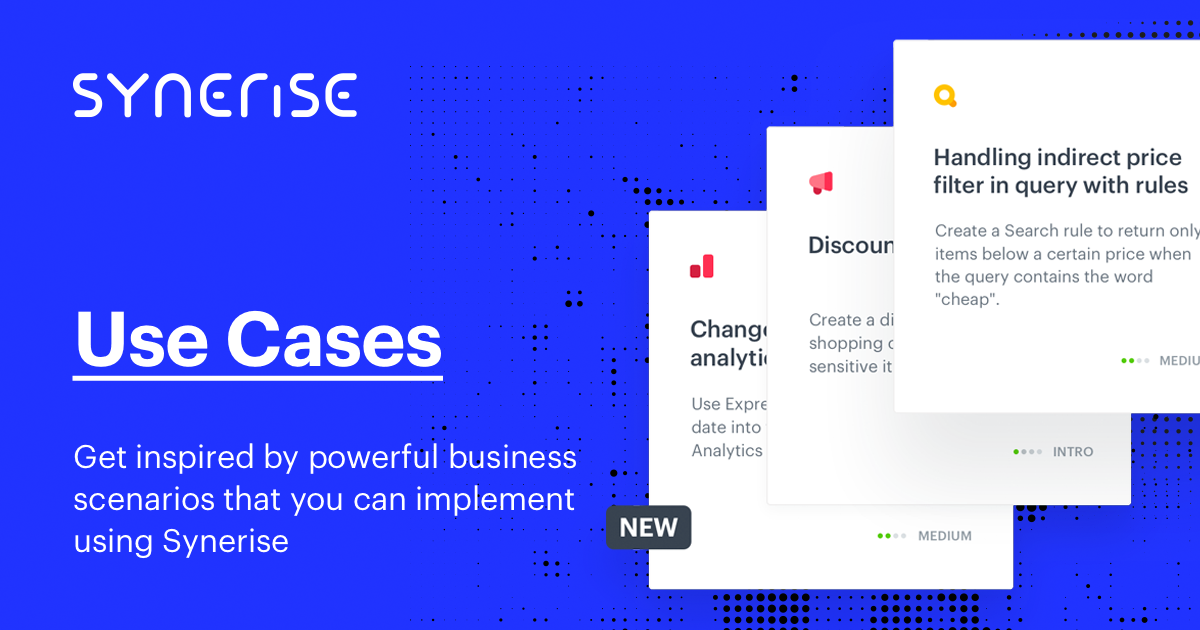STEP 1 Workspace & tracking code
Introduction
When you start working with Synerise, it is necessary to create your workspace and implement a tracking code to collect data about customer behavior. In this part, we will show you how to do it in a few simple steps.
From this chapter you will learn:
how to create workspace,
is it better to create one or more workspaces,
how to implement tracking code.
Workspace
It is necessary to provide information regarding the workspace and configure some data in the system. In this part, we will show you how to do it.
One or more workspaces
Synerise allows you to create one or more workspaces depending on your business needs. The workspace lets you manage your company information, billings, users and their permissions.
A workspace is where you collect data. If you have multiple websites or one website in multiple languages, you can:
- Create a workspace for each of them, to store data separately. You will need to create a tracking code in each workspace and use it on the corresponding site or sites.
- Create a shared workspace for multiple sites, to store data collected on those sites in the same database. You can use the same tracking code on all sites, or create multiple codes (data will still be sent to the same database).
- Installation & configuration - learn more about the installation and configuration.
- Cookies documentation - learn more about the cookies documentation in Synerise.]
Pros and cons of both options
As described above, to achieve cross-domain tracking, implementing tracking codes on each domain and store data under one workspace is enough. There is no limit to the number of tracked sites in a given workspaces, nor the types of languages, currencies or product feeds, therefore operations on a global scale are not a limiting factor for Synerise.
You can store as many product feeds as you like in the platform under one workspace. They may be multi-currency and multi-language, allowing to create as many AI models as needed. However, we know that each implementation is different and there may be different important factors of having one or more workspaces. Below, we provide you with a list of pros and cons, so that you can choose the most suitable solution for your business.
Pros and Cons of collecting data from different domains in one / separate workspaces:
| Number of business workspaces | PROS | CONS |
|---|---|---|
| One business workspace | Instant access to customer data from all domains. Campaigns are easy to duplicate. Access to all of the campaign statistics on one dashboard. Customer data enrichment from different domains will help to create better segmentation and use the 360° customer profile for better targeting. If we want to create cross-domain AI campaigns, data enrichment from the domains will help you to train the model and target the audience better. |
You mix our database from different domains within one workspace. The logic of source attributes is needed in order to properly manage the database. If several mobile apps are integrated, there will be a complication with push campaigns (there is no possibility to store different tokens under one workspace so there will be no possibility to use encryption of the pushes). Web push messages as above. If there are different agreement policies between the domains, you will have to create custom attributes to define the consent policy in the system. While sending a campaign, you should always pay attention to the chosen audience. If we collect transactional data in different currencies, you can not use default analytics dashboards for revenue. Custom dashboards will have to be created. |
| Two or more business workspace | Clear separation of the databases between the domains. Using Synerise-native marketing agreements. It is easier to manage the campaign setup (dynamic content, emails, etc.) because you don’t need to worry about checking the audience before sending (only the database from domain X) You also don’t need to indicate the direct URL/domain where the content will be displayed (you can just show content on all pages). In the system, you will find default revenue analytics dashboards. If you have different currencies on the domains, you will only be able to use those default analytics when you store transactions in separate workspaces. |
You will have to copy campaigns between the profiles. That will require more time. You will have to run separate integrations for each workspace. |
There is a possibility to transfer customer data between workspaces with the help of webhooks.
For now, you should copy campaigns manually between the workspaces.
Cross-domain scenarios worth remembering
Scenario: Anonymous user visits 2 domains from the same browser.
Outcome: User will have the same UUID (for example Synerise cookie) on each domain, so the user activity will be stored in Synerise under the same customer card. Exceptions are only in cases, when the user has already been identified on only one of the domains and is still anonymous on the other.
Scenario: Anonymous user visits 2 domains from the same browser, but then becomes identified on only one of the domains.
Outcome: When you identify a user on the domain (by sending the send form data event), the user UUID will be changed to a recognized one. From this point onwards, the user activity will be stored separately on the domains.
Scenario: Anonymous user visits 2 domains from the same browser, but then becomes identified on only one of the domains with an email which already exists in the database (for example, through a manual import).
Outcome: The anonymous profile will be merged by email address with the identified profile. The result is a single customer card.
Scenario: Anonymous user visits 2 domains from the same browser, but then the user becomes identified on both domains with the same email.
Outcome: Both UUIDS will be saved under the one customer card in Synerise, which will let you have the customer’s behavioral history in one place. However, UUIDs will remain different on the browser level (in case they were different from the beginning).
Scenario: Anonymous user visits 2 domains from the same browser, but then becomes identified on both domains with different emails.
Outcome: UUIDS will be saved under separate customer cards in Synerise. The email will be merged with the UUID from each domain. In case the user had the same UUIDs on both domains from the beginning, then there will be a new UUID generated using the method “Send form data” (this method triggers the UUID reset in such cases).
Workspace users
When your account is created, you can think about adding your team to Synerise. Invite new users to the workspace.
- If you want to create more roles than the default ones (roles are used for permission management):
- Go to Settings > Access groups.
- Click Add role.
- Name and save the role.
- Edit the permissions of the role.
- Go to Settings > Users and click Invite.
- Fill in the details.
- Assign a role or roles to the user.
- Send the invitation.
Watch our video to see how to add new roles and edit the permissions for each of them.
If you want to establish a clear process of decision making with regard to campaigns, you can assign reviewers and an approver. These users will be responsible for verifying the quality and correctness of the campaign templates and approving them.
Read more about approval services here.
- Identity access management - learn more about identity access managements.Among this chapter in documentation you will find information about:
Tracking code
Tracking code implementation is the first step of integration. It is responsible for collecting data in our system. The tracking code allows us to set up a profile in Synerise and collect basic events such as page.visit, session.start, session.end.
This script also initiates Synerise SDK, which allows you to integrate web push, track forms, set dynamic content on the website, and much more.
See in our video how to generate our tracking code.
- Adding a tracking code - learn more about adding a tracking code step by step.
- JS SDK installation & configuration materials - learn more about JS SDK installation & configuration materials.
Implementation
To properly integrate a website with our platform, the tracking code must be added to the website. You should copy the script code by clicking Copy to dashboard and paste it into the code of each sub-page on the website before the </body> closing tag.
The tracking code can be found in Settings > Tracking Codes.
Event authentication settings
By default, JS SDK collects some events without any authentication and since it’s running on a website, you should consider adding the authentication element here for sensitive elements that you want to implement, such as transactional events. For that we provide a JWT token-based identity verification where we validate if incoming data has a valid JWT token for a given user. It’s up to you to define which events can be accepted anonymously and which require JWT tokens.
- Events settings - learn more about the events settings.
Worth considering:
-
Choosing one integration way only
If you choose to place the tracking code directly into the website code, you must remember that the rest of the integration should be done in exactly the same way (for example transactional events, form events, custom events, and so on).
It is important because in some cases, GTM might be blocked by plugins such as ad blockers, but our tracking code placed directly into the source code will not be blocked. So, if you choose to do all of the integration directly through the source code of the website and send form events through GTM, it might cause a situation where page visits will be tracked properly, but form events will not be collected for the visitor. -
We strongly encourage you to activate custom domain tracking.
Custom domain tracking involves placing our SDK on a link within the client’s domain to treat Synerise as 1st party data. This helps to bypass ad blocks and ghosters that might block your requests. It is a very helpful and highly recommended solution.
Why is this integration needed? Custom domain tracking is a way to maintain tracking and handle the tracking protection mechanism introduced by:- browsers (Safari’s Intelligent Tracking Prevention (ITP) or Mozilla’s Enhanced Tracking Protection (ETP))
- ad blockers (adblock, ublock etc.)
VERIFICATION - SEE THE CHECKLIST
This section provides a verification checklist for TRACKING CODE INTEGRATION to ensure that all of the necessary steps are taken. It includes a list of information that must be collected and evaluated to make sure that everything works.
Learn more →- Third party tracking - Learn more about the third party tracking.
Tracking code variants
There are several versions of our tracking code. Each version has a different feature set.
- Tracking code variants - learn more about the tracking code variants.
SPA/PWA websites
If your website is in SPA (single-page application) or PWA (progressive web application) technology, you must add the tracker and send events in a different way.
- Tracking code in single page application - learn more about the tracking code in single page application.
Once this initial integration is done, you can start running your first campaigns on the website for anonymous customers!

